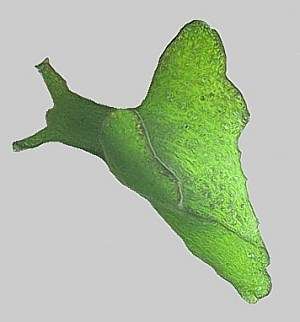
Crosslandia viridis
Eliot, 1903
Order: NUDIBRANCHIA
Suborder: DENDRONOTINA
Family: Scyllaeidae
DISTRIBUTION
Tropical Indo-West Pacific.
PHOTO
South of Kunduchi Beach, Dar es Salaam, Tanzania, October 1976, 26mm long, amongst hydroids on the seagrass Thalassodendron. PHOTO: Bill Rudman.
This strangely shaped dendronotoidean nudibranch looks very like a species of the sacoglossan genus Elysia. The rhinophores are hidden in small pockets at the tip of the tenatcle-like extensions to the front edge of the mantle. Crosslandia is closely related to Notobryon and Scyllaea, the latter adapted for life on floating pieces of brown algae. All members of the family feed on hydroids living on algae. Only one species is recognised from the Indo-West Pacific and it ranges from bright green to dull brown, apparently matching the algae or seagrass it is living on.
Reference:
• Thompson, T.E. & Brown, G.H. (1981) Biology and relationships of the nudibranch mollusc Notobryon wardi in South Africa, with a review of the Scyllaeidae. Journal of Zoology, 194: 437-444.
Rudman, W.B., 1999 (April 16) Crosslandia viridis Eliot, 1903. [In] Sea Slug Forum. Australian Museum, Sydney. Available from http://www.seaslugforum.net/find/crosviri
Related messages
Re: Crosslandia viridis from South Australia
July 23, 2007
From: Steve Leske
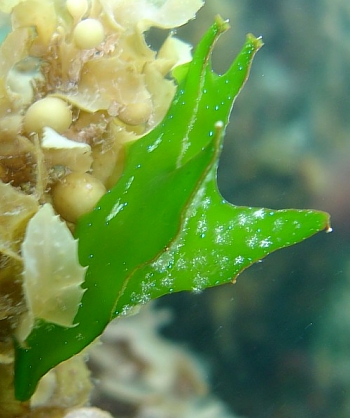
Concerning message #2876:
This is another sighting from South Australia.
Locality: Edithburgh, 2-3 metres, South Australia, Gulf St Vincent, 10 June 2007. Photographer: Steve Leske.
Steve Leske
octopus@chariot.net.au
Leske, S., 2007 (Jul 23) Re: Crosslandia viridis from South Australia. [Message in] Sea Slug Forum. Australian Museum, Sydney. Available from http://www.seaslugforum.net/find/20102Thanks Steve,
Your animal looks very like the Crosslandia viridis I recall from East Africa. It will be very interesting to see whether all the animals I have grouped here under that name turn out to be the same species
Best wishes,
Bill Rudman
Crosslandia viridis from Papua New Guinea
December 24, 2003
From: Ray Izumi
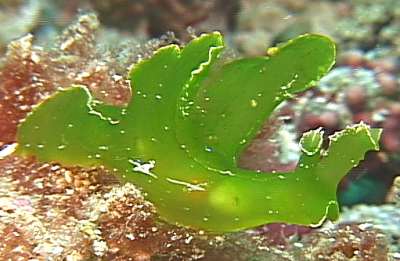
Here is a video still of a bright green Notobryon wardi from Quatto Island, Milne Bay, Papua New Guinea, taken in November 2003. We found it at 50 feet in a field of Halimeda weed. Size about 2.5 cm.
Ray Izumi
izumirm@sprynet.com
Izumi, R., 2003 (Dec 24) Crosslandia viridis from Papua New Guinea. [Message in] Sea Slug Forum. Australian Museum, Sydney. Available from http://www.seaslugforum.net/find/11731Dear Ray,
I think this is the related Crosslandia viridis. This group of species are quite rarely found, probably because they are so well camouflaged, so every record we can get is of interest to help us understand their colour variability, and get an idea how many species there are.
Best wishes
Bill Rudman
Radula of Crosslandia viridis
September 14, 2002
From: Bill Rudman
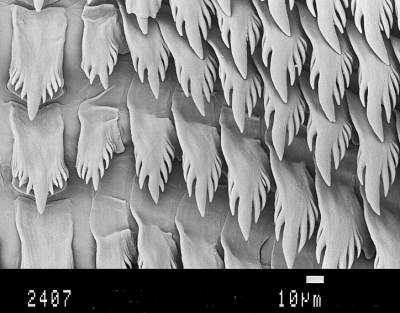
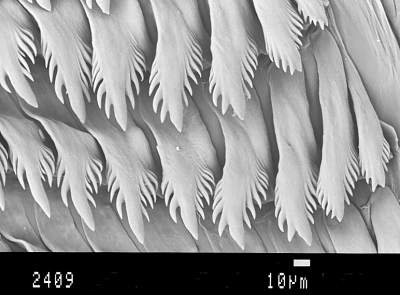
Here are some SEM photos of the radula of Crosslandia viridis.
PHOTOS: Angourie, nthn New South Wales, Australia, 7 October 1979. AM C117729. Upper photo showing the central region of the radular ribbon and the inner laterals on the right side. Lower photo shows outer teth on the right side. Photos: Geoff Avern.
Scyllaea pelagica, like Crosslandia viridis, has a central radular tooth, closely flanked on each side by lateral teeth. Notobryon wardi, on the other hand, lacks a central tooth.
Bill Rudman
Rudman, W.B., 2002 (Sep 14) Radula of Crosslandia viridis. [Message in] Sea Slug Forum. Australian Museum, Sydney. Available from http://www.seaslugforum.net/find/7937Crosslandia viridis from Heron Island
April 20, 2001
From: Julie Marshall
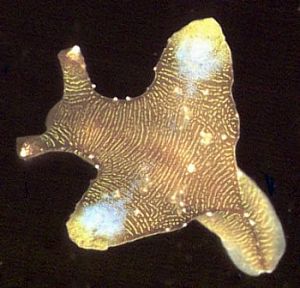
Dear Bill,
On my most recent visit to Heron Island [Great Barrier Reef] I found this tiny (5 mm) Crosslandia viridis on the dark green algae, Codium spongiosum, which made it very obvious despite its small size. The photo shows the rhinophores emerging from the long pocket-like extensions on the head and the transparent gills showing as white dots on the insides of the parapodia (or wings). It was found on 7 March 2001 at low tide at the reef crest on the northern side of the island.
Best wishes,
Julie Marshall
j.marshall@latrobe.edu.au
Marshall, J., 2001 (Apr 20) Crosslandia viridis from Heron Island. [Message in] Sea Slug Forum. Australian Museum, Sydney. Available from http://www.seaslugforum.net/find/4176Dear Julie,
There aren't many records of Crosslandia from anywhere in the Indo-West Pacific so this is a very interesting find. I think there are probably as many records on the Forum as there are in the published literature. I had always assumed that it was a green animal but it seems it is either quite variable in colour or there is more than one species.
Best wishes,
Bill Rudman
Crosslandia viridis from South Australia
August 17, 2000
From: Stuart Hutchison
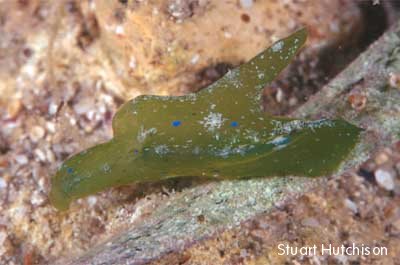
Dear Bill,
Here is a Crosslandia viridis that Ron Greer discovered in 2m water at Point Turton Jetty, Yorke Peninsula, SA in about Mid 1998. It was about 20mm long.
Regards,
Stuart
hutchco@tpg.com.au
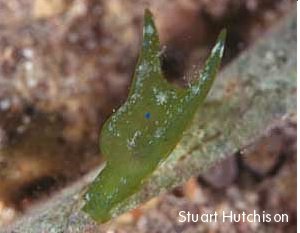
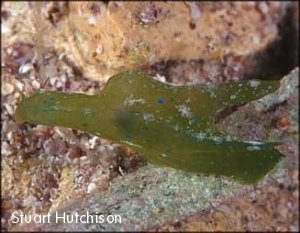
Thanks Stuart,
It's good to get photos and records of this rarely reported species. Athough it looks as though it is a herbivorous sacoglossan, it is in reality a hydroid-feeding dendronotoidean related to the pelagic nudibranch Scyllaea pelagica.
To those of you who are unfamiliar Crosslandia, have a look at the photo at the top of the page. In Stuart's photos the head [at the right side] is obscured by the large anterior parapodial lobe.
Best wishes,
Bill Rudman.
Crosslandia? from Port Stephens
April 16, 1999
From: David & Leanne Atkinson
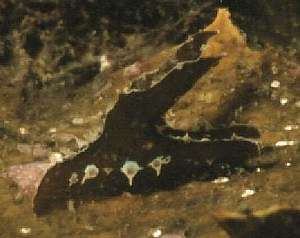
Hi Bill,
Here is a creature found and photographed by Judy Martin who was diving with is over Easter at Port Stephens [New South Wales, Australia]. The closest we could find was Crosslandia viridis but the colour (brownish green) and spots (bright blue) seem different. It was eating kelp.
David & Leanne Atkinson
atkin@hunterlink.net.au
Atkinson, D. & L., 1999 (Apr 16) Crosslandia? from Port Stephens. [Message in] Sea Slug Forum. Australian Museum, Sydney. Available from http://www.seaslugforum.net/find/775Dear David & Leannne,
I am pretty sure this is the brown 'form' of Crosslandia viridis. [See green version at Top of Page] It is certainly an amazing shape. From the side, as in your photo, the edge of the body in front of the large wing-like parapodia, forms a large raised ridge which terminates in the forward projecting rhinophore stalks/pockets.
The shape seems to be a way of camouflaging the animals on the brown algae or green seagrasses on which they are found. Although almost always found on plants, they are not herbivores, feeding instead on hydroid colonies which live on the plants.
Best wishes,
Bill Rudman.
